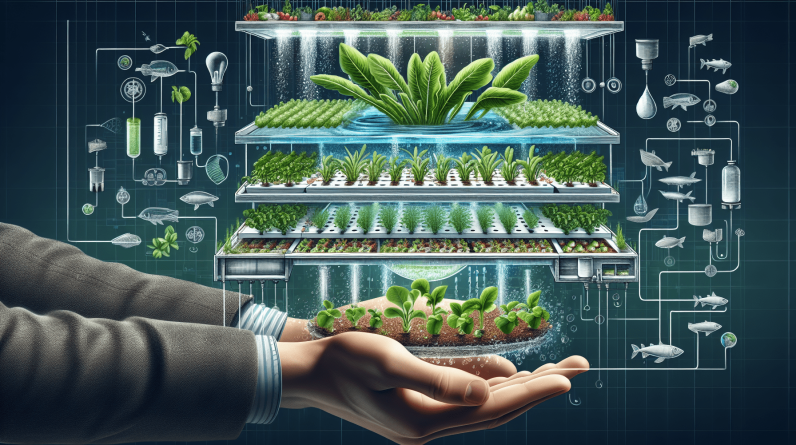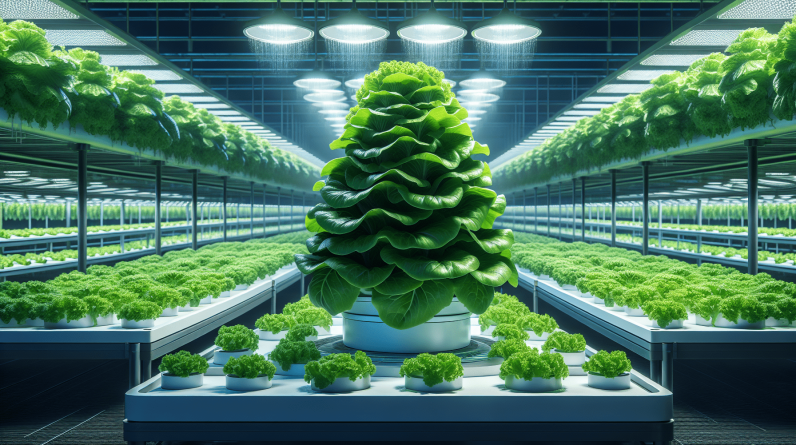
Are you interested in learning about the Benefits of Hydroponic Growing Systems? Well, you’ve come to the right place! In this article, we will explore the advantages of using hydroponic systems for gardening and how they can revolutionize the way you grow plants. Let’s dive into the world of hydroponics together and discover how you can benefit from this innovative growing method.
What are Hydroponic Growing Systems?
Hydroponic growing systems are a method of growing plants without soil. Instead of using traditional soil-based gardening, hydroponic systems deliver nutrients directly to the plant roots in a water-based solution. This allows plants to grow faster and produce more abundant harvests compared to soil-grown plants.
Did you know that with hydroponics, you can grow plants without the need for soil? It’s truly a revolutionary way of gardening that offers numerous benefits for both hobbyists and commercial growers alike.
Types of Hydroponic Systems
There are several types of hydroponic systems, each with its unique characteristics and benefits. Some common types include:
- Deep Water Culture (DWC): In this system, plant roots are submerged in a nutrient solution, providing constant access to essential nutrients.
- Ebb and Flow System: This system uses a timer to flood the plant roots with nutrient solution and then drain it, allowing for aeration.
- Nutrient Film Technique (NFT): Nutrient solution flows through a narrow channel, delivering nutrients directly to roots while maintaining continuous flow.
- Drip System: Nutrient solution is dripped onto the plant roots from above, ensuring a consistent supply of nutrients.
Each type of hydroponic system has its advantages and is suitable for different plant varieties and growing conditions.
Have you ever wondered about the different types of hydroponic systems available? Each system has unique features that cater to specific plant needs and growing environments.

This image is property of pixabay.com.
Benefits of Hydroponic Growing Systems
Now, let’s delve into the numerous benefits of using hydroponic growing systems for your plants.
1. Faster Growth and Increased Yield
One of the significant advantages of hydroponics is that it allows plants to grow at a much faster rate compared to traditional soil gardening. By providing essential nutrients directly to the plant roots, hydroponic systems eliminate the need for plants to search for nutrients in the soil. This results in faster growth and higher yields, making it an efficient and productive gardening method.
2. Water Conservation
Hydroponic systems are extremely water-efficient, using up to 90% less water than traditional soil-based gardening. In hydroponics, water is recirculated within the system, reducing wastage and conserving water resources. This makes hydroponic systems an environmentally friendly choice for water-conscious gardeners.
3. Year-Round Cultivation
One of the most significant advantages of hydroponic systems is the ability to grow plants year-round, regardless of external weather conditions. By providing a controlled environment with optimal light, temperature, and humidity levels, hydroponic systems allow for continuous cultivation of plants throughout the year. This is particularly beneficial for growers in regions with extreme climates or limited growing seasons.
4. Reduced Risk of Soil-Borne Diseases and Pests
Since hydroponic systems do not use soil, they eliminate the risk of soil-borne diseases and pests that commonly affect traditional soil-grown plants. By growing plants in a sterile and controlled environment, hydroponic systems promote healthier plant growth and reduce the need for chemical pesticides or fungicides. This results in cleaner, pest-free crops and reduces the environmental impact of chemical treatments.
5. Space Efficiency
Hydroponic systems are incredibly space-efficient, making them an ideal choice for urban gardeners or those with limited gardening space. By growing plants vertically or in compact systems, hydroponics allow you to maximize your growing area and cultivate a more extensive variety of plants in a smaller space. This makes hydroponic gardening an excellent option for small apartments, balconies, or indoor spaces.
6. Nutrient Control
With hydroponic systems, you have complete control over the nutrients your plants receive. By adjusting the nutrient solution based on plant requirements, you can ensure that your plants receive the optimal balance of essential nutrients for healthy growth. This level of control enables you to customize the nutrient solution to meet the specific needs of different plant varieties, resulting in more robust, healthier plants.
7. Sustainable and Eco-Friendly
Hydroponic systems are a sustainable and eco-friendly gardening method that reduces water usage, eliminates chemical inputs, and promotes healthy plant growth. By conserving water, reducing wastage, and minimizing environmental impact, hydroponics offer a more sustainable approach to growing fresh, nutritious crops. Additionally, hydroponic systems can be designed using recycled materials or renewable energy sources, further enhancing their eco-friendly appeal.
8. Versatility and Adaptability
Hydroponic systems are highly versatile and adaptable, allowing you to grow a wide variety of plants, including fruits, vegetables, herbs, and flowers. Whether you’re interested in growing leafy greens, tomatoes, peppers, or strawberries, hydroponics can accommodate diverse plant species and growing preferences. This versatility makes hydroponic systems suitable for hobbyists, commercial growers, and educational institutions seeking to explore new plant varieties and cultivation methods.
9. Enhanced Nutritional Value
Studies have shown that plants grown hydroponically can have higher nutritional value compared to soil-grown plants. By providing plants with a precisely balanced nutrient solution, hydroponic systems promote healthier plant growth and increased nutrient absorption. This results in produce with higher vitamin and mineral content, offering you fresher, more nutritious crops for your consumption.
10. Cost-Effective Long-Term Investment
While the initial setup cost of a hydroponic system may be higher than traditional soil gardening, it can be a cost-effective long-term investment. With increased plant growth rates, higher yields, and reduced water and chemical usage, hydroponic systems offer a return on investment in the form of more abundant harvests and healthier plants. Over time, the savings on water, pesticides, and fertilizers can offset the initial setup costs, making hydroponic gardening a financially viable option for gardeners looking to maximize their yields.
Troubleshooting Common Hydroponic System Failures
Despite the numerous benefits of hydroponic systems, you may encounter common issues or failures that can affect plant growth and system performance. Here are some common hydroponic system failures and how you can troubleshoot them:
-
Nutrient Deficiency: If your plants exhibit signs of yellowing leaves or stunted growth, they may be experiencing a nutrient deficiency. To address this issue, check the pH and nutrient levels of your solution and adjust them accordingly to provide plants with the necessary nutrients.
-
Root Rot: Root rot can occur in hydroponic systems with poor aeration or water circulation, leading to decay and wilting of plant roots. To prevent root rot, ensure proper oxygenation and drainage in your system and monitor water circulation to maintain root health.
-
Algae Growth: Algae growth can be a common issue in hydroponic systems exposed to excessive light or nutrients, resulting in clogged tubing or nutrient imbalances. To control algae growth, minimize light exposure to nutrient solutions, maintain proper nutrient levels, and regularly clean and sterilize system components to prevent algae buildup.
-
Pests and Diseases: While hydroponic systems reduce the risk of soil-borne diseases, they may still be susceptible to pests or airborne diseases that can affect plant health. To combat pests and diseases, practice good hygiene, inspect plants regularly for signs of infestation, and use natural pest control methods to protect your crops without chemical inputs.
-
pH Fluctuations: Fluctuations in pH levels can affect nutrient uptake and plant growth in hydroponic systems, leading to nutrient deficiencies or toxicities. Monitor pH levels regularly and adjust the pH of your nutrient solution to maintain a stable and optimal growing environment for your plants.
By troubleshooting common hydroponic system failures and taking proactive measures to address issues, you can maintain healthy plant growth, maximize yields, and enjoy the benefits of hydroponic gardening year-round.
Final Thoughts
As you can see, hydroponic growing systems offer numerous benefits that can revolutionize the way you garden and grow plants. From faster growth and increased yields to water conservation, reduced pest risks, and space efficiency, hydroponics provide a sustainable, efficient, and environmentally friendly approach to cultivating fresh, nutritious crops. Whether you’re a beginner gardener or an experienced grower, hydroponic systems offer a versatile, innovative, and rewarding way to grow a wide variety of plants in any environment.
So why not consider trying out hydroponic gardening and experience the benefits firsthand? With its long-term advantages and sustainable practices, hydroponics can transform your gardening experience and help you cultivate healthy, vibrant plants with ease.
We hope this article has inspired you to explore the world of hydroponics and discover the endless possibilities it offers for your gardening endeavors. Happy growing!










